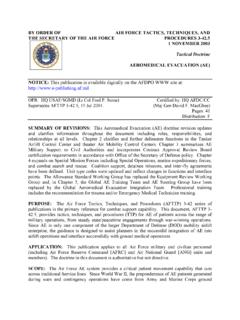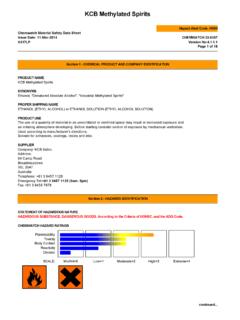Transcription of Tactical Doctrine CRITICAL CARE AIR TRANSPORT …
1 BY ORDER OF AIR FORCE TACTICS, TECHNIQUES, AND THE SECRETARY OF THE AIR FORCE PROCEDURES 7 APRIL 2015 Tactical Doctrine CRITICAL care AIR TRANSPORT TEAM (CCATT) _____ ACCESSIBILITY: This publication is available on the Air Force e-Publishing website at RELEASIBILITY: There are no release restrictions on this publication. _____ OPR: HQ AMC/SGK Certified by: HQ AF/SG3/5X Supersedes: AFTTP , 7 Sep 2006 (Col Elmo Robison) Pages: 63 _____ PURPOSE: The Air Force Tactics, Techniques, and Procedures (AFTTP) 3-42 series of publications is the primary reference for combat support capability.
2 This document, AFTTP , provides tactics, techniques, and procedures (TTP) for air TRANSPORT of critically ill or injured patients across the range of military operations, from steady state/peacetime engagements through war-winning operations. This guidance is designed to assist commanders and planners in the successful integration of CCATT into Aeromedical Evacuation (AE) operations, and interface successfully with Air Force Expeditionary Medical Support (EMEDS) or equivalent component service medical support and AE ground medical operations. Ensure that all records created as a result of processes prescribed in this publication are maintained in accordance with Air Force Manual (AFMAN) 33-363, Management of Records, and disposed of in accordance with Air Force Records Information Management System (AFRIMS) Records Disposition Schedule (RDS) located at This publication applies to all Air Force personnel, including Air Force Reserve Command (AFRC) and Air National Guard (ANG).
3 For the purpose of this TTP, ANG is included in the term Major Command (MAJCOM). The Doctrine in this document is authoritative but not directive. The use of the name or mark of any specific manufacturer, commercial product, commodity, or service in this publication does not imply endorsement by the Air Force. This publication requires the collection and/or maintenance of information protected by the Privacy Act (PA) of 1974, 5 United States Code (USC) Section 552a. Forms affected by the PA have an appropriate PA statement. SUMMARY OF CHANGES: The following is a summary of changes to the CCATT TTP: addition of paragraph in SCOPE to address possibility of CCATT being tasked/employed outside the traditional AE organization; deleted the following: (Personnel nominated for assignment to a CCATT Unit Type Code (UTC) after 1 Sep 2006 are required to go through the validation process described herein.)
4 Members assigned to CCATT UTCs who successfully completed the CCAT Initial Course prior to 1 Sep 2006 will validate through attending the CCAT Advanced Course) (paragraph ); (Responsibility and Authority), adds a section that discusses the Theater En Route CRITICAL care Director (paragraph ); deletes Communications & Computer 2 AFTTP 7 APRIL 2015 Support (formerly paragraph ); adds further information/guidance on the requirement for an Official Passport (paragraph ); addition of a section that defines CCATT Tasking & Employment (paragraph ); expands guidance for CCATT on space-limited fixed-wing airframes (paragraph ); provides guidance for operations on non-AE missions (paragraph ); provides information on the definition of peacetime taskings (paragraph ); CCATT Duty/Rest Cycle Day is updated (paragraph ); updated information on Ground/Mission Support Operations (paragraph ); additional documentation requirements for completion of the 3899L (paragraph ); CCATT Quality Improvement/Performance Improvement (QI/PI) Process information is added (paragraph ); Operational Support Flying information is broken out into a separate chapter (Chapter 4); adds information on body armor requirements for CCATT personnel (paragraph ); Training chapter is re-numbered (Chapter 5).
5 Changed Air Reserve Component (ARC) training frequency for CCAT Advanced Course to every 24 months (paragraph ); and finally a paragraph that discusses the Operational CCATT Kit Program ( ) is added. SCOPE: United States Air Force (USAF) aeromedical evacuation provides a CRITICAL patient movement capability that cuts across traditional Service lines. Since World War II, the preponderance of AE patients generated during wars and contingency operations have come from Army and Marine Corps ground combat units. It is important that the en route care capabilities of all Services integrate well to support the care and movement of patients throughout the continuum.
6 Moreover, during the past decade, it has become increasingly important that en route care capabilities continue to integrate with components of our nation's allies. Historically, in operational settings, CCATTs have typically been embedded in AE units. CCATTs will continue to be an integral component of USAF AE, however, in future operations there may be situations where CCATTs will be tasked to deploy and operate outside traditional USAF AE forces to provide CRITICAL care support in the en route care continuum. When tasked for a non-traditional CCATT role, the team would not be assigned to an AE unit or Operations Group but would be aligned under a different execution and command and control organization.
7 CCATTs could also deploy in a Defense Support to Civil Authority (DSCA) scenario where the CCATTs may be assigned to the En Route Patient Staging System (ERPSS) to help prepare patients for evacuation at the Aerial Port of Embarkation (APOE) or at the Aerial Port of Debarkation (APOD) to facilitate movement of patients to the receiving hospitals. Unless specifically stated, this TTP will primarily address CCATT as an AE asset outlining specific roles and functions while operating within the AE organization. When CCATTs are assigned to an AE unit, they will follow the AE chain of command under the Operations Group. Air Mobility Command (AMC) is the Manpower and Equipment Force Packaging System (MEFPAK) responsible agency (MRA) for the CCATT.
8 AFTTP 7 APRIL 2015 3 Table of Contents Page Chapter 1 CRITICAL care AIR TRANSPORT TEAM (CCATT) CCATT Mission 5 CCATT Concept 5 Range of Operations 5 CCATT Scope of care 5 CCATT UTCs Capabilities and Compositions 6 CCATT Candidate Selection & Validation 7 Chapter 2 COMMAND AND CONTROL General 12 AE Integration in Air Mobility Operations 12 En Route care Capability 13 Contingency AE Structure 13 Responsibility and Authority 13 Chapter 3 OPERATIONS Scope 16 Force Health Protection 16 CCATT Relationship with Aeromedical Evacuation Crew Members (AECMs) 16 Support 16 Official Government Passport 17 Mission Essential Items 17 Tasking and Employment 17 CCATT Duty/Rest Cycle 21 Flight Operations 23 Ground Operations 24 Documentation 25 CCATT Quality Improvement/Performance Improvement (QI/PI) Program 26 Security 26 Chapter 4 OPERATIONAL SUPPORT FLYING Operational Support Flier (OSF)
9 28 Flight Operations Protective Clothing & Equipment 28 Aeronautical Orders 29 Aviation Service Code/Flight Authorization Code 32 Flight Authorization Chapter 5 TRAINING 32 Introduction 33 Unit CCATT Coordinator 33 Entry into CCATT Training 33 Training Pipeline 34 4 AFTTP 7 APRIL 2015 Chapter 6 LOGISTICS Allowance Standards 38 Pre-Flight of Equipment 39 Narcotics Accountability 40 Aircraft Medical Equipment Operations 40 Medical Equipment Waiver Protocol 40 Medical Equipment Malfunction/Failure 40 Base Operating Support 42 Resupply and Patient Movement Items (PMI) 43 Operational CCATT Kit Program 43 Attachment 1 Glossary of References and Supporting Information Attachment 2 Validation Process Flowchart 46 51 Attachment 3 Sample Cover Letter for Application Packages for CCATT Candidates 52 Attachment 4 Sample Letter of Rebuttal 53 Attachment 5 CCATT Candidate Application Package Clinical Validation Committee Checklist Coversheet 54 Attachment 6 CCATT Minimum Individual Protective Clothing & Equipment for Flight Operations (Initial)
10 55 Attachment 7 CCATT Minimum Individual Protective Clothing & Equipment for Flight Operations (Deployed) 56 Attachment 8 CCATT Requirements Matrix 57 Attachment 9 Request for Waiver of Initial Aeromedical Evacuation Patient Staging (AEPS) Course 61 AFTTP 7 APRIL 2015 5 Chapter 1 CRITICAL care AIR TRANSPORT TEAM (CCATT) CCATT Mission. CCATTs assist in carrying out the global patient movement mission. They are a limited, rapidly-deployable resource available in selected situations to supplement en route care patient movement capabilities.
















